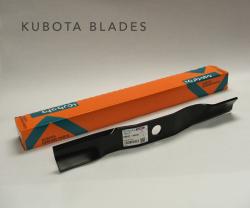LawnEQ is a trusted source for genuine OEM Parts- Shop for the part you need from your favorite manufacturers such as Landpride, Toro, Kubota, and more today on our OEM Parts Lookup Tool!
While your engine gets you cruising along, its your blades that do all of the hard work. Without them, you’d just be rolling over the grass, not taking it down. With a blade that’s in poor shape, you’ll end up with a ragged, messy lawn that has been battered and shredded more than it has been cut. While you can take you mower to a local maintenance guy, there’s no reason you can’t maintain it yourself.
Blade Condition
Before sharpening or balancing a used blade, you’ll want to make sure it’s worth the effort. A blade that is warped, creased, or otherwise severely damaged is trash, and should just be replaced. Depending on the objects you might run across in your yard, your blade may even need to be replaced on a yearly basis. Most can make it a few years before needing to be replaced though. Don’t over-think buying a replacement, there’s not that much of a difference from one brand to another.
Sharpening Your Blade
You can sharpen your mower blade with a grinder or a file. Bench grinders are the best way to go, but they are also a luxury for most people who do not work with metal on a regular basis. More likely, you’ll go with a hand-held grinder such as a Dremel, or go with a file. The latter is the most labor intensive, but is also the most efficient and least likely to result in you ruining the blade. Some mowers or replacement blades come with their own sharpening kits.
When sharpening the blade, make sure only to sharpen the side that faces upward, towards the mower engine. Sharpening both sides of the blade will lead to a bad cut. The side that faces the engine should have a bevel. Simply run the file or grinder across it until it is sharp enough. Don’t oversharpen it – blades that are too sharp will dull quickly.
Balancing Your Blade
One of the consequences of sharpening a blade is that you are removing material from it. The blade itself is not a particularly heavy piece of material, so removing too much material from one end versus the other can create an imbalance. Use an inexpensive balancing cone and check to see if the blade is stable. If one side drops lower, that side will need to be ground down a little further until the blade stays even.
Installing Your New Blade
Every once in a while, you’ll have a person say they are having issues with their mower, they just had the blade off and sharpened it themselves, and they’re sure it was sharp enough. However, the mower isn’t delivering a good cut. What’s at fault?
95% of the time, they reinstalled the blade upside-down. It’s an easy mistake to make, because you’re often reinstalling with the mower on its side or upside down. So, if you install the blade the way it seems to make sense to install it, you’re actually putting it in upside down, causing the dull back side of the blade to be the leading edge. Just take it off and reinstall it right-side up.
This really is about the easiest thing you can do when it comes to maintaining your mower. Just make sure to take the proper safety precautions – such as wearing gloves and making sure the spark plugs have been removed before turning the mower on its side – and it should be a quick fix.







